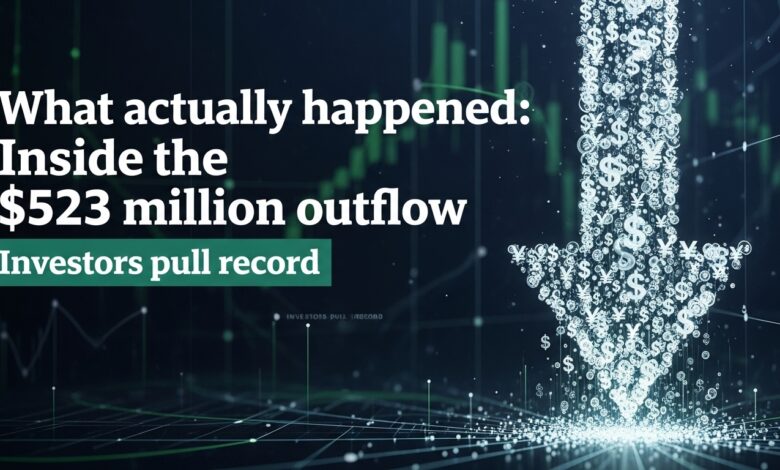Bitcoin price today: dips to $92k as Fed cut doubts spark risk-off mood
Bitcoin price today trades near $92K as doubts over Fed rate cuts fuel a risk-off mood. See what’s driving BTC, key levels to watch, and what could happen next.

Fed cut doubts. QSAs Bitcoin price today hovers around the $92,000 mark, traders are waking up to a very different market mood than just a few weeks ago. After setting fresh highs above $120,000 in October, BTC has slid almost 30%, even briefly breaking below $90,000 earlier this week as investors rushed to reduce risk amid growing doubts that the Federal Reserve will deliver more aggressive interest rate cuts.
In other words, the same macro forces that helped push Bitcoin to record levels are now working in reverse. Uncertainty over future Fed rate cuts, a shaky global risk sentiment, and heavy profit-taking from institutional players have created a classic risk-off environment. That has left even die-hard crypto bulls asking whether this is just a sharp correction in a long-term bull market or the start of a deeper drawdown.
At the same time, Bitcoin’s volatility is nothing new. Historically, deep pullbacks have often appeared right in the middle of major bull cycles, shaking out leveraged traders and resetting sentiment before the trend resumes. But with the Fed signaling more caution and markets heavily focused on macro data, the narrative this time is more entangled with monetary policy, inflation, and interest rates than ever before.
In this in-depth BTC price analysis, we’ll break down where Bitcoin price today stands, why the market is suddenly risk-off, what the Fed has to do with it, and the scenarios traders are watching over the coming weeks.
Bitcoin price today: how far has BTC really fallen?

As of the latest data, Bitcoin price today is trading around $92,000, with an intraday range that has seen lows near $88,500 and highs above $93,000. That puts BTC down sharply from its October peak near $126,000, wiping out the year’s gains and returning the market to levels last seen several months ago.
Earlier this week, BTC even dropped below the $90,000 level for the first time in about seven months, a move that underscored how quickly sentiment can switch from euphoria to caution. Analysts point to a combination of macro uncertainty, fading hopes of rapid Fed easing, and forced selling from leveraged players as key drivers of the latest slide.
Despite the drawdown, Bitcoin remains one of the best-performing major assets on a multi-year basis. Its long-term trend is still intact, but the path higher is clearly no longer a straight line. For traders focused on the Bitcoin price today, the critical question is whether this zone near $90K–$95K becomes a new base of support or just a temporary stop on the way to deeper levels like $80K or even the widely watched $75K support.
Intraday action and technical zones to watch
On the shorter time frames, the BTC price has been chopping in a relatively wide range, reflecting a tug-of-war between dip buyers and risk-off sellers. Volatility picked up sharply after the coin lost support around $98,000, with many traders forced to unwind leveraged long positions as cascading liquidations pushed the price lower.
Key technical areas many analysts are watching include:
The $90,000 psychological level, which has already been tested from below and above and now acts as a pivot. The $98,000–$100,000 area, formerly strong support, now a potential resistance zone if BTC attempts a relief rally. The $75,000 region, highlighted in several analyses as a deeper support area that could come into play if risk-off pressure intensifies. For long-term holders, these levels matter less than the big-picture Bitcoin trend, but for active traders the Bitcoin price today in relation to these zones helps define strategies—whether to hedge, wait on the sidelines, or carefully scale into positions.
Why is Bitcoin dipping as Fed cut doubts grow?
The latest Bitcoin selloff isn’t happening in a vacuum. It’s closely tied to shifting expectations about Federal Reserve rate cuts and a broader reassessment of risk across global markets.
Only a few weeks ago, traders were almost certain that the Fed would keep easing policy with further cuts in December. Now, that confidence has faded, and markets are treating a December rate cut as a coin flip rather than a done deal.
Fed rate-cut expectations: from certainty to doubt
Minutes from recent Fed meetings and public comments by several officials have revealed a deep split within the FOMC. While some members favor more cuts to support a cooling labor market, others worry that inflation remains too sticky to justify aggressive easing. That has left investors unsure whether the next Fed decision will bring another cut or a prolonged pause.
This uncertainty matters for Bitcoin price today because BTC has become tightly linked to the macro environment. In lower-rate regimes, liquidity tends to be more abundant, the U.S. dollar weaker, and speculative assets like cryptocurrencies more attractive. When the market starts to believe that rates might stay higher for longer, risk assets often sell off together.
Higher yields, stronger dollar, weaker risk appetite
The shift in Fed expectations has also impacted U.S. Treasury yields and the dollar index, both important pieces in the Bitcoin puzzle. As traders price in fewer or slower rate cuts, yields on longer-dated Treasuries have nudged higher, tightening overall financial conditions.
Higher yields and a resilient dollar typically weigh on risk-on assets like:
Growth stocks, particularly high-valuation AI and tech names. Emerging market equities and high-yield credit.Crypto assets, including Bitcoin and major altcoins like Ethereum. Recent equity market weakness, especially in tech-heavy indices, has reinforced the risk-off mood. With AI-related stocks under pressure and major indices seeing sizable pullbacks, Bitcoin has followed suit. Risk is being priced more conservatively across the board, and BTC remains at the far end of that risk spectrum.
Sentiment spillover: from Wall Street to crypto

Several surveys and reports indicate that global fund managers have dialed back risk and raised concerns about stretched valuations, particularly in sectors like technology and private credit. Bitcoin, which had been a beneficiary of the hunt for performance earlier in the year, is now getting hit as that appetite cools.
What makes the Bitcoin price today especially sensitive is the overlap between crypto-native traders and macro-focused funds. Many institutional players who embraced BTC as a “high-beta macro asset” are quick to de-risk when volatility spikes, amplifying moves both up and down. In a risk-off environment, that often means heavier selling, even from those who remain long-term bullish on digital assets.
Risk-off mood and crypto contagion
As Bitcoin has sold off, the impact has rippled through the broader crypto market and even into traditional financial assets with heavy crypto exposure.Fed cut doubts.
Crypto stocks and miners feel the pain
Shares of publicly listed companies with large Bitcoin treasuries, as well as major Bitcoin mining firms and crypto exchanges, have dropped alongside BTC. When Bitcoin falls, these companies’ earnings outlooks and balance sheets are directly impacted, making them highly sensitive to BTC price volatility.
This “contagion” effect can work both ways. On the way up, miners, exchanges, and Bitcoin-heavy corporates often amplify crypto rallies as their share prices surge. On the way down, they can deepen the gloom, reinforcing the message that the crypto cycle is in a risk-off phase.
Liquidity, leverage, and liquidations
Another layer to the story is leverage. During strong uptrends, traders pile into futures and perpetual swaps, often using high leverage to chase price momentum. When sentiment reverses, that leverage becomes a vulnerability.
Significant liquidations of long positions as BTC broke key supports. Reduced appetite from spot buyers, making it harder for the market to absorb forced selling. Ongoing deleveraging across exchanges, which can extend volatility in the short term. These dynamics help explain why the Bitcoin price today isn’t just gently drifting lower but instead experiencing sharp intraday swings and sudden spikes in volume—classic signs of a market in the middle of a repricing phase.
Macro vs. crypto-native drivers: what really matters for BTC now?
When traders talk about Bitcoin price today, they often focus on charts, patterns, and on-chain metrics. But in the current environment, it’s hard to ignore how dominant macro forces have become.Fed cut doubts.
key scenarios for Bitcoin after the $92K dip
No one can predict with certainty what Bitcoin price will do next, but understanding the main scenarios can help traders frame the risks and opportunities.
Scenario 1: Macro calm and a relief rally
In a more constructive scenario, upcoming economic data come in soft enough to validate the idea of further Fed rate cuts, but not so weak that they trigger outright recession fears. Fed communication shifts slightly more dovish, and markets regain some confidence that policy will remain supportive.
Risk sentiment could improve, helping BTC reclaim levels above $100K. Previously aggressive sellers may start to cover shorts, adding fuel to a short squeeze. Long-term investors who sat out the earlier highs might see the current levels as an attractive entry point, increasing spot demand.
While this doesn’t guarantee a rapid return to all-time highs, it would support the idea that the move to $92K was a deep but ultimately healthy correction.
Scenario 2: Higher-for-longer rates and deeper downside
The more bearish scenario centers on a higher-for-longer interest rate narrative. If inflation proves sticky and the Fed signals fewer or delayed cuts, markets may further unwind risk positions.
For Bitcoin, that could mean:
A sustained break below $90K, opening the door to a retest of the $75K support zone highlighted by multiple analysts. Continued outflows from leveraged positions and from institutional players under pressure to reduce volatility. Prolonged consolidation in a lower trading range as the market digests previous excesses. While painful in the short term, such a scenario doesn’t necessarily invalidate the long-term Bitcoin bull case. Historically, crypto markets have weathered multiple large drawdowns before resuming their uptrends. However, it would demand patience and strong risk management from market participants.
Scenario 3: Choppy sideways market with elevated volatility
A third, and often underrated, possibility is that Bitcoin price today near $92K marks the beginning of an extended sideways consolidation. In this scenario, neither bulls nor bears fully control the market.
Price might oscillate between, say, $80K and $105K, driven by alternating waves of macro news, technical trading, and changing sentiment. For traders, this environment can be both frustrating and full of opportunity, depending on how adept they are at navigating volatility without overexposing themselves.
How traders and investors can think about Bitcoin now
Risk management first: Volatile assets like Bitcoin can move quickly in both directions. Position sizing, diversification, and clear time horizons matter more than ever.
Separate time frames: Short-term traders and long-term holders may interpret the same BTC price move very differently. A 20–30% drop might be a stop-out signal for a leveraged trader but a buying opportunity for a multi-year investor.
Avoid reacting purely to headlines: While Fed news and macro data are crucial, knee-jerk reactions can lead to buying tops and selling bottoms. Many seasoned investors focus on frameworks rather than single events.
Ultimately, Bitcoin price today at $92K reflects a complex mix of macro uncertainty, market positioning, and normal crypto volatility. How you interpret that level depends heavily on your strategy, risk tolerance, and time horizon.Fed cut doubts.
Conclusion
The slide in Bitcoin price today to around $92,000 is a clear stress test for the current bull cycle. Doubts over future Fed rate cuts, a shift from risk-on to risk-off sentiment, and heavy deleveraging have combined to push BTC significantly lower from its recent highs.
Yet, in the broader context of Bitcoin’s history, sharp drawdowns are not unusual. The key questions are whether the macro backdrop stabilizes, if the Fed can slowly pivot without reigniting inflation, and how strongly long-term holders and new institutional entrants continue to support the asset.
For now, the market sits at an inflection point. A more hawkish turn and persistent uncertainty could drag BTC into a deeper and more prolonged correction.
It is a fully global, macro-sensitive asset that responds to everything from Fed minutes to AI stock valuations. Understanding that interplay is essential to making sense of where Bitcoin price today might be headed tomorrow.
FA
Q. Why did Bitcoin price today drop to around $92K?
Bitcoin’s dip toward $92,000 is mainly tied to a shift toward risk-off sentiment as investors question how many more Fed rate cuts are coming. Profit-taking after a strong bull run and leveraged liquidations have amplified the move.
Q. How closely is Bitcoin linked to Federal Reserve decisions now?
Bitcoin has increasingly behaved like a macro-sensitive asset. Lower interest rates and looser financial conditions often support higher BTC prices by boosting liquidity and risk appetite. That said, long-term structural factors like adoption and halving cycles still matter a lot.Fed cut doubts.
Q. Could Bitcoin fall further from the current $92K level?
Yes, further downside is possible. In a higher-for-longer rate environment, investors might continue trimming exposure to high-volatility assets.
Q. Is this correction the end of the Bitcoin bull market?
A correction to $92K doesn’t automatically mean the bull market is over. Crypto cycles often include multiple sharp drawdowns within a broader uptrend. Whether this marks the end of the cycle or a mid-bull-market reset will depend on how macro conditions evolve, how quickly risk appetite returns, and whether long-term investors keep accumulating. Many previous Fed-related dips in BTC eventually faded into the background on longer-term charts.
Q. Should I buy Bitcoin at $92K now?
That’s a personal decision that depends on your financial situation, goals, and risk tolerance. This article cannot provide individualized investment advice. Generally, it’s wise to assess how much volatility you can handle, consider diversifying rather than going all-in, and avoid investing money you cannot afford to lose. If you’re unsure, consulting a licensed financial adviser can help you decide whether exposure to Bitcoin price today fits your overall plan.Fed cut doubts.
See more;Cryptocurrency Bill: Restricted or Prohibited Cryptocurrency Countries




